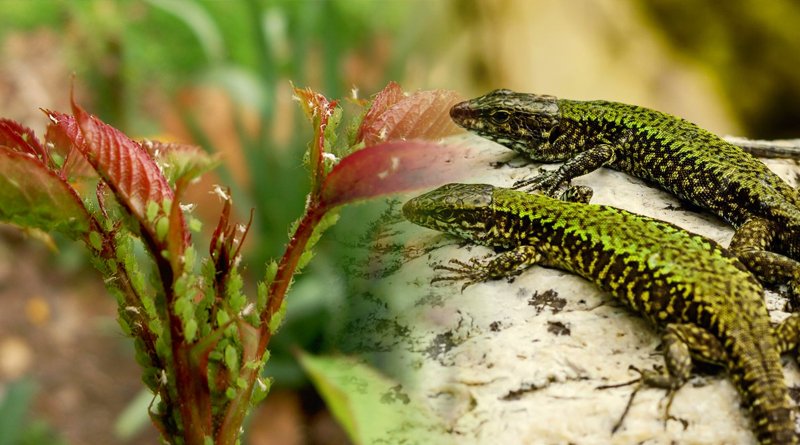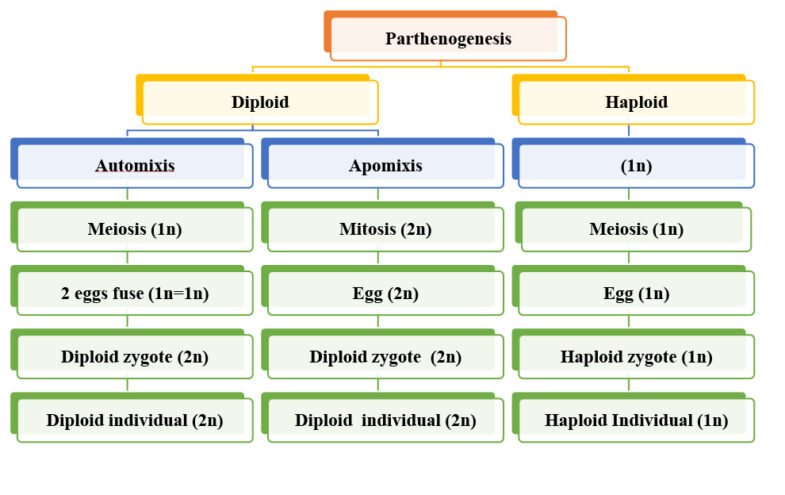Parthenogenesis is considered an asexual form of reproduction, but more precisely, it is an incomplete form of sexual reproduction

Normally, eukaryotic multicellular organisms (plants and animals) produce their offspring by the process of sexual reproduction (fertilization): male gamete(1n) and female gamete(1n) combine during fertilization and lead to form the zygote(2n) that undergo cell division and leads to the formation of an organism. Sometimes, they undergo development through asexual reproduction (parthenogenesis): a kind of self-imprinting during which an unfertilized egg produces the zygote that further develops into an organism. Parthenogenesis takes place in both plants as well animals.
The word parthenogenesis is a combination of “Parthenos”, meaning virgin, and “genesis”, meaning birth. It is the development of an offspring from a female’s ovum without fertilization (mating of male and female gametes).
Animals that undergo the process of parthenogenesis are described as a parthenogenic animal. Parthenogenesis is considered an asexual form of reproduction, but more precisely, it is an incomplete form of sexual reproduction because offspring develop from gametes.
Normally, gametes (the reproductive cells) undergo meiosis: a reduction division in which chromosomes of diploid cells (2n) undergo fission. As a result, four haploid cells (1n) are produced.
Parthenogenesis is part of the apomixis process in plants. The process of parthenogenesis mainly occurs in invertebrates, including wasps, helminths, water fleas, mites, bees, scorpions, and other insects. Invertebrate animals such as amphibians, reptiles, few birds, and fish species (sharks) have been found.
Types of Parthenogenesis
Parthenogenesis is divided into haploid and diploid parthenogenesis based on the number of chromosomes in the offspring.
Haploid Parthenogenesis
An embryo develops from an unfertilized ovum, during which the oocyte (1n) haploid chromosomes develop into a zygote with haploid chromosomes (1n), and ultimately a haploid organism is produced because of mitotic division. There is no fusion with other cells, mainly found in bees and other Hymenoptera members. It is facultative, means an organism develops from an oocyte when a male is not available.
Diploid Parthenogenesis
A diploid Oocyte (2n) is produced because of defective meiosis and undergoes further division without fertilization. A diploid offspring are produced in the case of diploid parthenogenesis. After zygote formation, no meiosis leads to the production of a diploid organism. It is obligate parthenogenesis and is mainly found in Coccoidea, Hemiptera, and curculionid beetles.
The diploid parthenogenesis is further divided into automixis and apomixis:
Automixis parthenogenesis (Meiotic Parthenogenesis)
The oocyte fuse with the polar body and produces a zygote that leads to the development of an embryo and, ultimately, an organism. The merging of the egg and polar body stimulates the new alleles’ production, and an offspring similar but not a full clone of the mother is produced. As the offspring is produced after getting an X-chromosome, in the case of automixis parthenogenesis, mainly female and rarely male is produced.
Apomixis parthenogenesis (Apomictic or Automatic)
A mature egg cell leads to the production of an embryo, which is diploid. There is no meiosis during the egg production process, and egg cells undergo cell division, embryo, and offspring formation. Such an offspring will be a full clone of the mother. Such kind of parthenogenesis is mainly found in plants.
Facultative parthenogenesis occurs in organisms that can produce offspring through sexual and asexual reproduction. These organisms undergo asexual reproduction when males are not available. In the case of obligate parthenogenesis, organisms reproduce only through asexual reproduction, for example, some reptiles (lizards).
Classification tree
Mechanism
Ovaries produce oocytes (egg cells) from precursor cells by meiosis and the production of three polar bodies (meiotic byproduct). In the case of sexual reproduction, these polar bodies degenerate as humans but in other organism’s ovum fuse with polar bodies and lead to the production of a zygote as in meiotic parthenogenesis.
The ovum fuse with the second polar body, and there is genetic diversity in the next generation. These offspring will be diploid, as in the case of automixis.
There are few conditions concerning the fate of offspring:
- Arrhenotokous: Parthenogenetically development of male from unfertilized eggs
- Thelytokous: Condition of female development from an unfertilized egg via parthenogenesis
- Deuterotokous: Condition in which an unfertilized egg can develop into either male or female.
Insects can reproduce in sexual and asexual ways under favorable conditions. They undergo an asexual way of reproduction and expand their population rapidly. While under harsh or unfavorable conditions, the insect undergoes sexual reproduction, produce eggs that can survive in harsh conditions, and develop to hatch during favorable conditions.
Asexual reproduction is advantageous for expanding the insect population shortly, and sexual reproduction enhances genetic diversity.
Some insects, like honeybees, undergo sexual reproduction to produce soldiers and workers via gametes production and asexual reproduction to produce a queen via parthenogenesis. Other insects lack males and reproduce asexually as obligatory parthenogenic.

Benefits
Parthenogenesis is self-reproduction, in which plants and animals produce their next generation alone without wasting time and energy searching for a suitable male. These parthenogenic females spend their time searching for food and shelter.
They reproduce their offspring under favorable conditions for better growth and survival success. For example, aphids undergo parthenogenesis in summer, when many green leaves are available and the days are long.
Parthenogenic animals reproduce two times faster than their sexual reproduction and quickly increase population size without fertilization. Females that reproduce by parthenogenesis can produce the same number of offspring as sexually reproduced females but with only half the size of the population, saving more resources.
The parthenogenic female can produce a colony without the demand of males, and most female offspring may grow quickly and reproduce new offspring within a short time.
Moreover, some parthenogens can maintain the ability to incorporate new genes during the cycle of sexual reproduction. Therefore, they can maintain their evolutionary process while producing many offspring.
Sexual reproduction does have greater genetic diversity than parthenogenesis. However, it may prove beneficial because it produces clones with the same genes inherited from their parents for favorable traits. So, if the mother lives in a habitat she has adapted to, her offspring will carry the same genes to ensure survival in such an environment.
Nowadays, parthenogenesis is tested via egg stimulation in humans for the development of parthenogenic individuals.
Disadvantages of Parthenogenesis as a Form of Reproduction
It is a form of asexual reproduction, thus, it is characterized by a lack of genetic diversity, since the offspring only gets all genetic material from one parent. Lack of genetic diversity predisposes the offspring to the same diseases and same conditions as its parent.
Moreover, negative mutations, as well as unfavorable traits, will persist for many generations. Furthermore, the offspring produced by parthenogenesis is a parent clone, so it cannot adapt easily or survive when the condition changes and becomes unfavorable. That’s why it may produce many organisms that cannot survive through any slight change in their environment.
Kashif Hussain1, Maria Kausar1, Muhammad Sohail Sajid1, Urfa Bin Tahir1, from 1Department of Parasitology, University of Agriculture, Faisalabad-Pakistan. Corresponding author can be reached at Kashif Hussain kashifdr32@gmail.com

